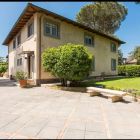The art of fighting fair.
Prior to a few weeks ago, my knowledge of martial arts was based exclusively on the films Enter The Dragon, The Karate Kid, and the complete works of Chuck Norris. Naturally, it was a pleasure to take several lessons at Romes Otzuka Club, a school dedicated solely to fighting sports.
But to wax philosophical for a moment, martial arts are strict disciplines that require the concentration of mind, body and spirit, to use the words of Otzuka Club president Danilo Capuzi. Each form, from karate to kung fu, has its own unique style with the same ultimate goal: self-defence. In Rome, it is a refreshing contrast to find this kind of discipline in a city where stoplights and street signs are nothing more than rough guidelines for driving.
Capuzi gladly invited me to Otzuka Club to get a taste of martial arts, provided the club would not be held responsible for injury or dismemberment. When the first thing you see after entering the club is a wall of deadly swords, sickles and spears, dismemberment is suddenly a concern.
When Capuzi was 13 years old, he developed a keen interest in self-defence after encountering several bullies at school. Nineteen years later, he is the ten-time Italian national champion of sanda a sport akin to judo and kickboxing. He has never lost a match in Italy. Coincidentally, bullies are no longer a problem.
Sanda is Chinese for unbound hand. It is a full-contact sport meant to resemble actual combat. This means kicking, punching, grappling, throwing and wrestling. On the other side of the gym, seasoned veterans were sparring with protective gloves and headgear. One fighter punched another in the head so fiercely that his helmet flew off, revealing an understandably bewildered face beneath.
Thankfully, the first lesson only consisted of learning how to fall: teeth gritted, chin tucked, arms out, a process not very different from taking a charge in basketball. Next I was paired with Manuela, a soft-spoken, young Italian woman, who started to kick me. As she kicked, Capuzi taught how to evade by calmly shuffling the feet and then grabbing the offending leg, leaving the opponent vulnerable to the devastating counter-attack of choice. Luckily for Manuela, this opponent had yet to learn any devastating counter-attacks and she was safe, for the moment.
The next lesson was kung fu, which resembles sanda in the same way that ballet resembles break-dancing. We practised the wing chun style of kung fu, which was developed about 200 years ago by Shaolin nuns in China as a method for women to defend themselves against larger, stronger men. Instructor Luca Spogli described kung fu in such a poetic and passionate manner that it was hard to remember that it was actually a deadly style of fighting.
Spogli began by demonstrating a classic kung fu manoeuvre, a kind of crouching double punch known as two dragons emerging from the sea. As hard as I tried, I felt I couldnt do better than two lizards emerging from shallow end of pool. The important thing was that I was learning.
The next day was the final lesson at Otzuka Club in capoeira, the Brazilian art of dance fighting. Its roots have been traced back to a style of fighting used by African slaves in Brazil in the 1800s. When Portuguese slave owners outlawed the practice of capoeira, the slaves added new steps and began to practise to music, disguising the fights as dance. Originally practised by black slaves, it eventually swept across the whole of Brazil and today the entire population is familiar with the sports acrobatic and often hypnotic movements.
Instructor Maestro Canhu offered no first name, just maestro, or master. I introduced myself, but he said that wouldnt do. In capoeira, students are given names by their masters. Other students introduced themselves as Pirate and other ferocious-sounding names. As Maestro looked me up and down, I privately hoped to be called Flamethrower or A-bomb or some other name that would strike fear into the hearts of my enemies. Solemnly, Canhu finally said: From now on, I shall call you Canary.
Perhaps there are worse things than being named after a small, yellow finch, but not many. As Maestro taught me the basic movements of capoeira, I stood hypnotised by the other students in the class as they slid across the floor, flipping handstands and cartwheels. They began to spar, beginning each bout with a handshake and a cartwheel before starting their intricate dance. Everyone smiled and laughed like old school chums, a stark contrast to the sober energy of sanda and kung fu.
Capoeira isnt two people fighting, explained Patrizio Nanni, known to the class as Pappagallo, or Parrot. Capoeira is about friends all participating together.
Despite the fun you can have, martial arts are clearly not for everyone. At Otzuka Club, one cannot simply walk in and join a lesson. President Capuzi requires a lengthy interview with every prospective student. I want to make sure that people are courteous and respectful, Capuzi said. It is very easy for martial arts to turn into violence.
But when practised correctly, the sport is wonderful exercise for body and mind. Unlike the bench press at the local gym, you learn to react and to respond, to move with grace and poise. Well, at least most students move with grace and poise. This canary most certainly cannot fly that lesson starts next week.
For more information contact Federazione Italiana Judo Lotta
Karate Arti Marziali,www.fijlkam.it.
Scuola di Arti Marziali Otzuka Club. Via Baldo degli Ubaldi 147/a.
Tel. 066637670, www.otzukaclub.com.





















